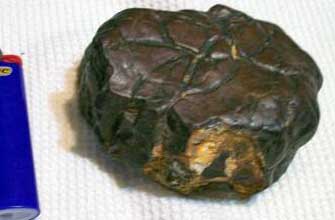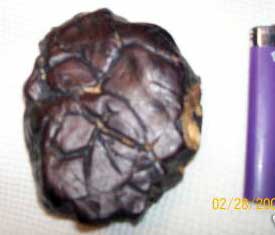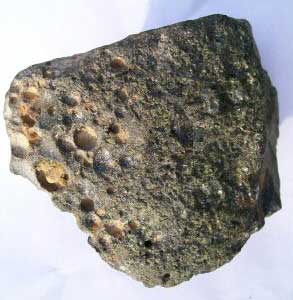| meteorite identification (appearance): Meteorites are often recognized by appearance but identified by their accompanying meteoritic properties. Wise sellers/collectors do not make assumptions based solely on appearance or circumstances when basic meteoritic traits are lacking. (At first glance the item below appears to have crust with expansion cracks, but closer examination reveals these are terrestrial weathering features.) |
eBay seller 'treasurehunterky' |
SIMPLE QUESTION TO 'TREASUREHUNTERKY'  
|
QUESTION (1-25-08) |
| meteorite identification (regmaglypts): Many people envision a meteorite as a burnt rock full of holes (like lava cinders). But meteorites are solid and may have surface pits or regmaglypts. Regmaglypts or thumbprints are elongated depressions like thumbmarks made in soft putty. Caused by ablation, scuplting can take many diferent forms especially when lower-melting-point minerals close to the surface melt away leaving holes (Goose Lake) or interesting shapes (Mundrabilla). Interestingly the size of the regmaglypts is usually proportional to the size of the meteorite. Small meteorites have small thumbprints, large meteorites have large thumbprints in most cases. (The circular depressions below are not regmaglypts.) |
| QUESTION TO 'TREASUREHUNTERKY' Auction # 250210096743 Ending Feb-02-08 Meteorite Unclassified "This Meteorite has fusion,thumbprints,good density and is magnetic and has visible iron traces of rusted ore,and wieghs 448 grams. Found in eastern ky.Being that most meteorites sell for ten dollars a gram this is a great deal and a great piece for collection or study. Thanks for looking at this item." 
|
| QUESTION (1-26-08) Question: Hi, This doesn't look like a meteorite. The indentions are too circular to be regmaglypts. And this does not look like fusion crust. How can you be sure it is not just iron ore? (1-29-08) Seller: unclassified means just that,but we have studied rock fomations for years and believe it to be a meteorite. My Thoughts: 'Unclassified means just that'? What? That's his answer to why this suspect meteorite is not just iron ore (not what one would expect from one studying 'rock formations for years'). He must have studied where "most meteorites sell for ten dollars a gram"! I won't pursue this nonsense any further. |
| Anyone can make a claim that they have found or own an authentic meteorite. It is entirely another matter to offer satisfactory proof of verification or classification from a Meteoritical Society approved institution. The photos or auction #'s on this page may link to meteorite auctions. In the opinion of this author, these auctions may lack either proper verification, credible history or photo, or reasonable supposition to qualify as genuine. This does not mean that they are not meteorites, only 'suspect' in the opinion of this author. The purpose of this site is to help the visitor better understand elementary identification of common meteorites and to gain insight from the misidentifications of others. |